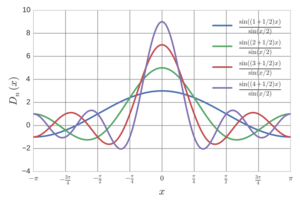Dirichlet kernel
In mathematical analysis, the Dirichlet kernel, named after the German mathematician Peter Gustav Lejeune Dirichlet, is the collection of periodic functions defined as
where n is any nonnegative integer. The kernel functions are periodic with period .

The importance of the Dirichlet kernel comes from its relation to Fourier series. The convolution of Dn(x) with any function f of period 2π is the nth-degree Fourier series approximation to f, i.e., we have where is the kth Fourier coefficient of f. This implies that in order to study convergence of Fourier series it is enough to study properties of the Dirichlet kernel.
Applications
In signal processing, the Dirichlet kernel is often called the periodic sinc function:
where is an odd integer. In this form, is the angular frequency, and is half of the periodicity in frequency. In this case, the periodic sinc function in the frequency domain can be thought of as the Fourier transform of a time bounded impulse train in the time domain:
where is the time increment between each impulse and represents the number of impulses in the impulse train.
In optics, the Dirichlet kernel is part of the mathematical description of the diffraction pattern formed when monochromatic light passes through an aperture with multiple narrow slits of equal width and equally spaced along an axis perpendicular to the optical axis. In this case, is the number of slits.

L1 norm of the kernel function
Of particular importance is the fact that the L1 norm of Dn on diverges to infinity as n → ∞. One can estimate that
By using a Riemann-sum argument to estimate the contribution in the largest neighbourhood of zero in which is positive, and Jensen's inequality for the remaining part, it is also possible to show that: where is the sine integral
This lack of uniform integrability is behind many divergence phenomena for the Fourier series. For example, together with the uniform boundedness principle, it can be used to show that the Fourier series of a continuous function may fail to converge pointwise, in rather dramatic fashion. See convergence of Fourier series for further details.
A precise proof of the first result that is given by
where we have used the Taylor series identity that and where are the first-order harmonic numbers.
Relation to the periodic delta function
The Dirichlet kernel is a periodic function which becomes the Dirac comb, i.e. the periodic delta function, in the limit
with the angular frequency .
This can be inferred from the autoconjugation property of the Dirichlet kernel under forward and inverse Fourier transform:
and goes to the Dirac comb of period as , which remains invariant under Fourier transform: . Thus must also have converged to as .
In a different vein, consider ∆(x) as the identity element for convolution on functions of period 2π. In other words, we have for every function f of period 2π. The Fourier series representation of this "function" is
(This Fourier series converges to the function almost nowhere.) Therefore, the Dirichlet kernel, which is just the sequence of partial sums of this series, can be thought of as an approximate identity. Abstractly speaking it is not however an approximate identity of positive elements (hence the failures in pointwise convergence mentioned above).
Proof of the trigonometric identity
The trigonometric identity displayed at the top of this article may be established as follows. First recall that the sum of a finite geometric series is
In particular, we have
Multiply both the numerator and the denominator by , getting
In the case we have as required.
Alternative proof of the trigonometric identity
Start with the series Multiply both sides by and use the trigonometric identity to reduce the terms in the sum. which telescopes down to the result.
Variant of identity
If the sum is only over non-negative integers (which may arise when computing a discrete Fourier transform that is not centered), then using similar techniques we can show the following identity: Another variant is and this can be easily proved by using an identity .[1]
See also
References
- ↑ Fay, Temple H.; Kloppers, P. Hendrik (2001). "The Gibbs' phenomenon". International Journal of Mathematical Education in Science and Technology 32 (1): 73–89. doi:10.1080/00207390117151. http://dx.doi.org/10.1080/00207390117151.
Sources
- Bruckner, Andrew M.; Bruckner, Judith B.; Thomson, Brian S. (1997). "15 Fourier Series §15.2 Dirichlet's Kernel". Real Analysis. Prentice-Hall. pp. 619–622. ISBN 0-13-458886-X. https://books.google.com/books?id=1WY6u0C_jEsC&pg=PA619.
- Podkorytov, A.N. (1988). "Asymptotic behavior of the Dirichlet kernel of Fourier sums with respect to a polygon". Journal of Soviet Mathematics 42 (2): 1640–6. doi:10.1007/BF01665052.
- Levi, H. (1974). "A geometric construction of the Dirichlet kernel". Transactions of the New York Academy of Sciences 36 (7 Series II): 640–3. doi:10.1111/j.2164-0947.1974.tb03023.x.
- Hazewinkel, Michiel, ed. (2001), "Dirichlet kernel", Encyclopedia of Mathematics, Springer Science+Business Media B.V. / Kluwer Academic Publishers, ISBN 978-1-55608-010-4, https://www.encyclopediaofmath.org/index.php?title=p/d032880
- Dirichlet kernel at PlanetMath
 |

